Abstract
An immune adherence hemagglutination assay (IAHA) and a modified enzyme-linked immunosorbent assay for antigenic characterization of human rotaviruses were developed. The designations of type 1 and type 2 were identical to those established previously by specific complement fixation, enzyme-linked immunosorbent assay, and immune electron microscopy. By IAHA (and modified enzyme-linked immunosorbent assay) certain animal rotaviruses were found to be closely related to human rotavirus type 1. The pattern of IAHA reactivity and the cell culture neutralization serotype were found to be distinct properties. The separation of neutralization and IAHA reactivity was apparent when animal rotaviruses which were distinguishable from each other by neutralization assays were found to share IAHA specificity. Further evidence for the dissociation of the neutralization and IAHA specificities was found in studies of human and bovine rotaviruses which underwent genetic reassortment during coinfection. Thus, it appeared that the IAHA and neutralization antigens were coded for by different genes. In view of these findings, we suggest that the term serotype be reversed to identify the antigen that reacts with neutralizing antibodies as is customary for other viruses and that the term subgroup (instead of serotype) be used for the specificity detected by specific complement fixation, enzyme-linked immunosorbent assay, and now IAHA.
Full text
PDF
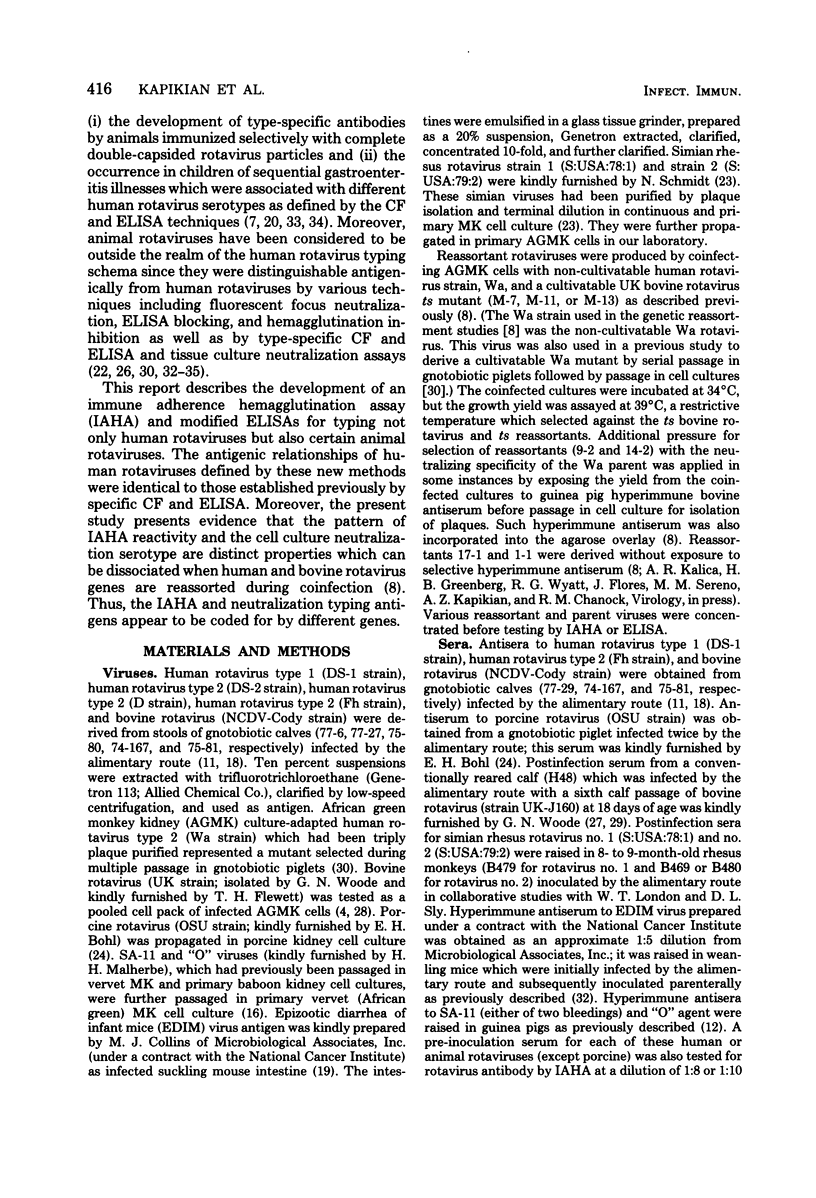
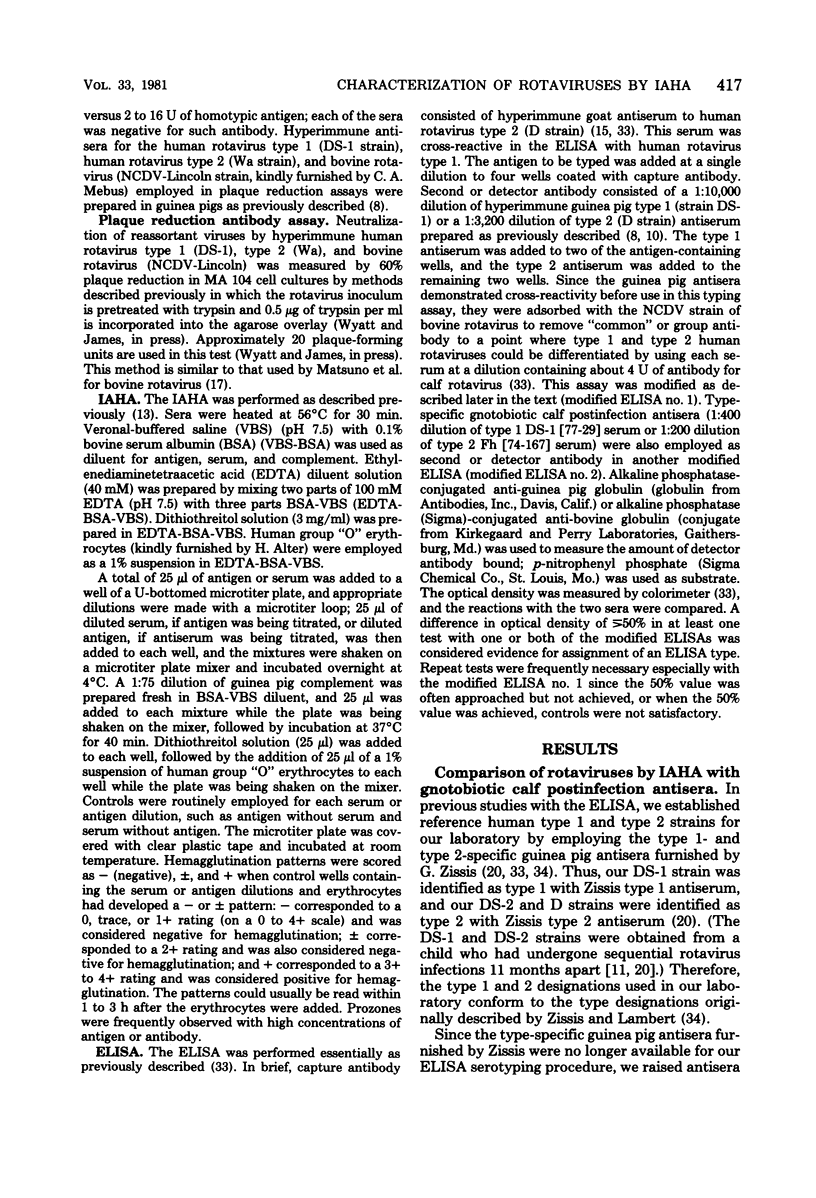




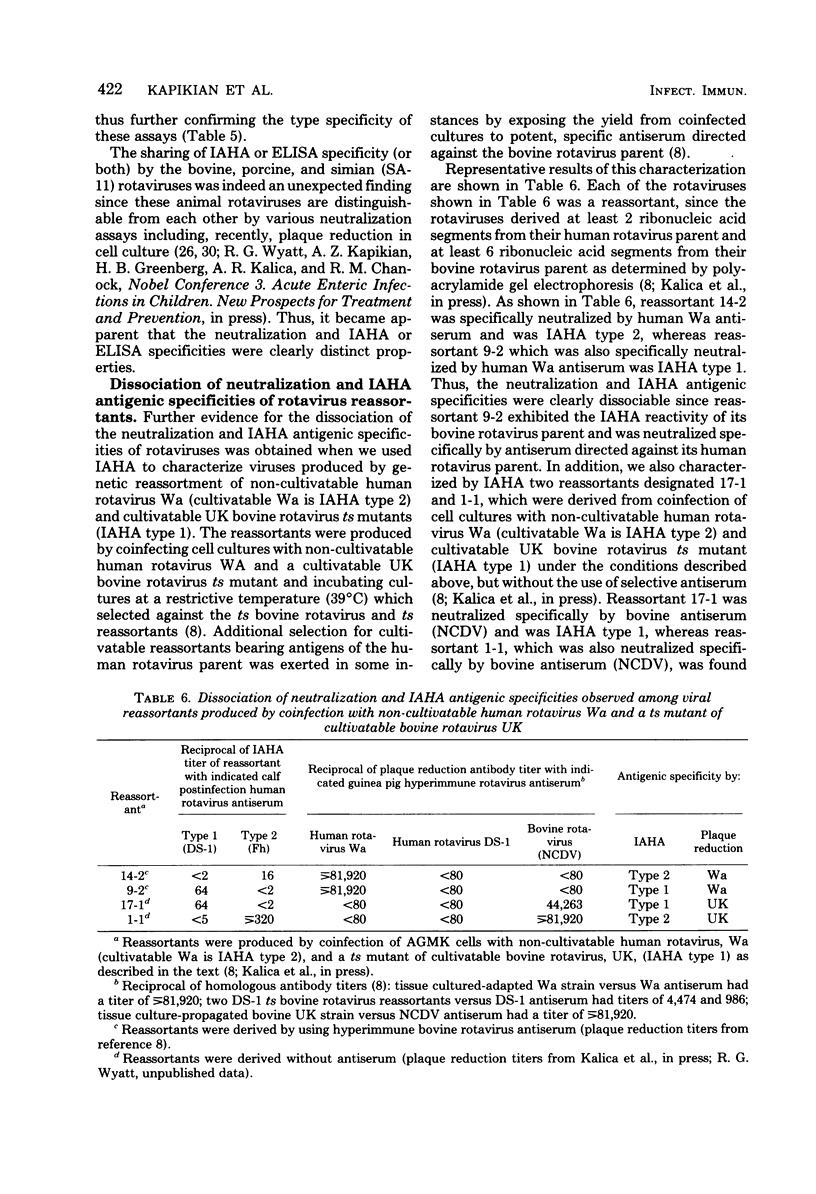

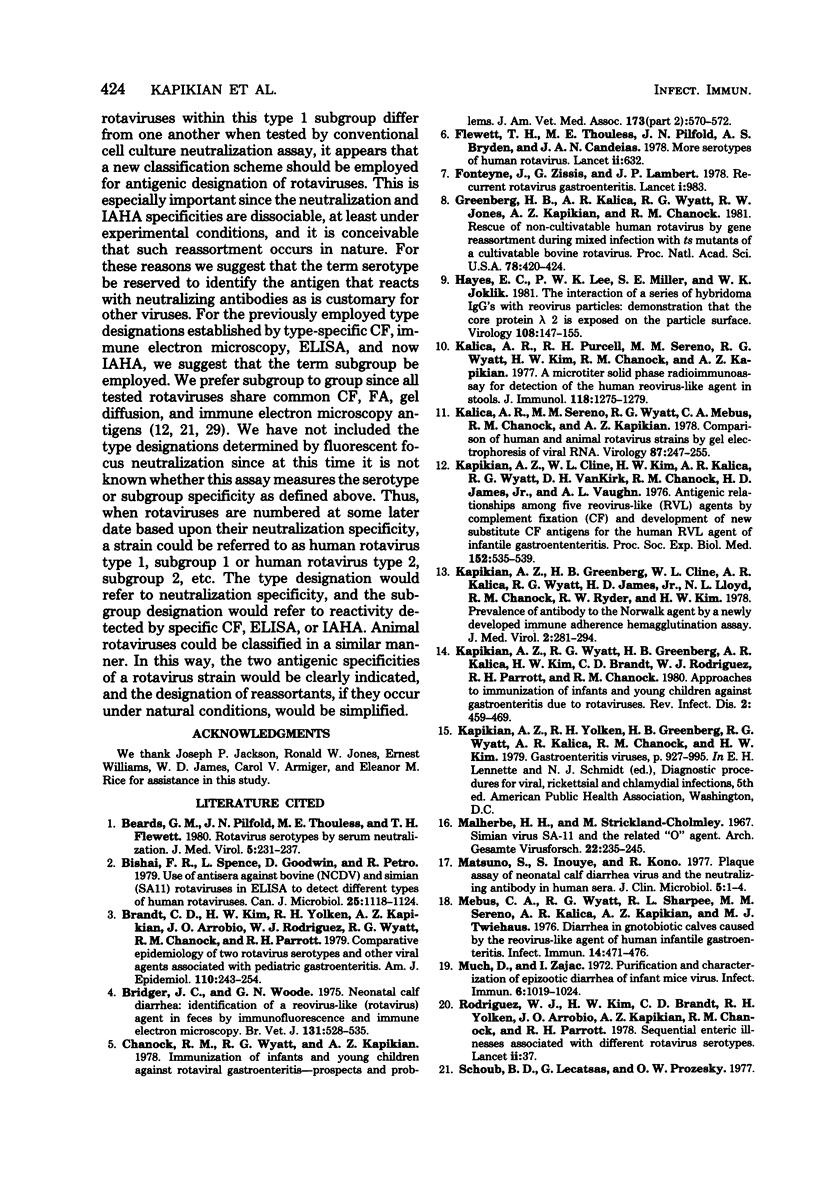
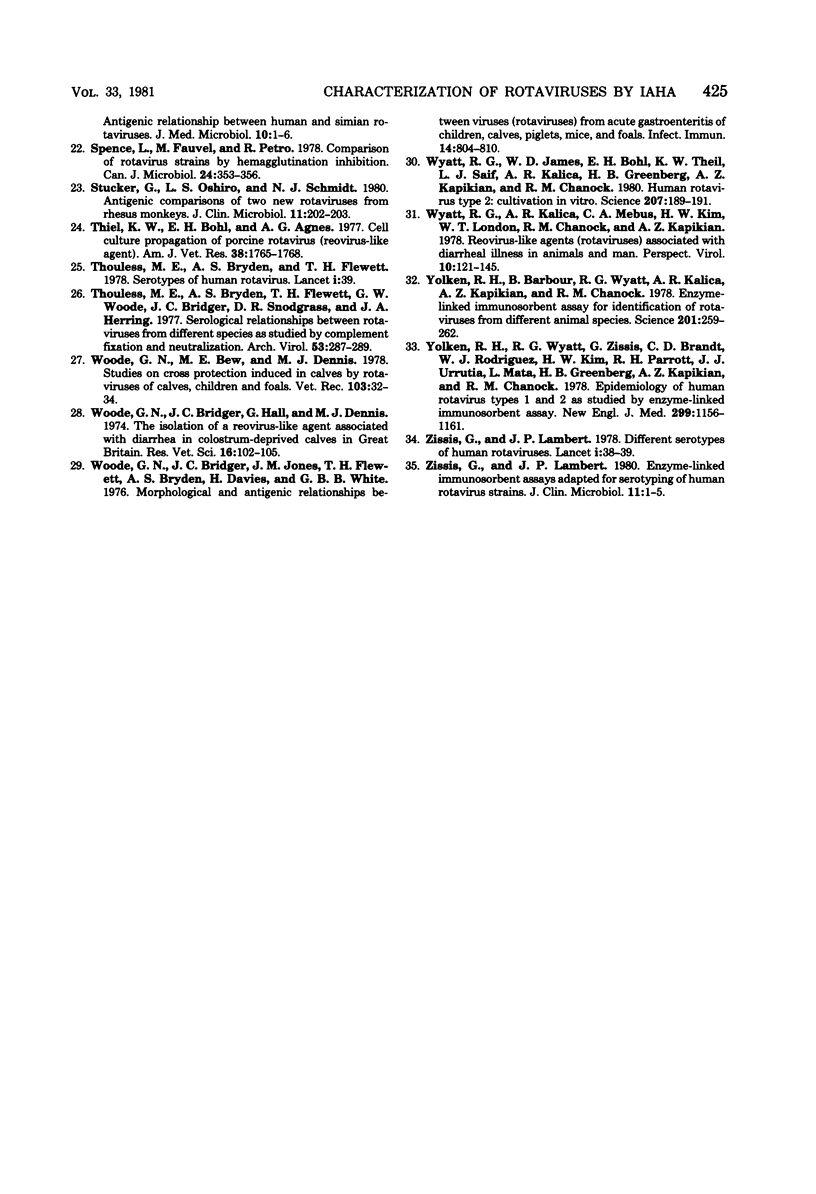
Selected References
These references are in PubMed. This may not be the complete list of references from this article.
- Beards G. M., Pilfold J. N., Thouless M. E., Flewett T. H. Rotavirus serotypes by serum neutralisation. J Med Virol. 1980;5(3):231–237. doi: 10.1002/jmv.1890050307. [DOI] [PubMed] [Google Scholar]
- Bishai F. R., Spence L., Goodwin D., Petro R. Use of antisera against bovine (NCDV) and simian (SA11) rotaviruses in ELISA to detect different types of human rotavirus. Can J Microbiol. 1979 Sep;25(9):1118–1124. doi: 10.1139/m79-174. [DOI] [PubMed] [Google Scholar]
- Brandt C. D., Kim H. W., Yolken R. H., Kapikian A. Z., Arrobio J. O., Rodriguez W. J., Wyatt R. G., Chanock R. M., Parrott R. H. Comparative epidemiology of two rotavirus serotypes and other viral agents associated with pediatric gastroenteritis. Am J Epidemiol. 1979 Sep;110(3):243–254. doi: 10.1093/oxfordjournals.aje.a112809. [DOI] [PubMed] [Google Scholar]
- Bridger J. C., Woode G. N. Neonatal calf diarrhoea: identification of a reovirus-like (rotavirus) agent in faeces by immunofluorescence and immune electron microscopy. Br Vet J. 1975 Sep-Oct;131(5):528–535. [PubMed] [Google Scholar]
- Chanock R. M., Wyatt R. G., Kapikian A. Z. Immunization of infants and young children against rotaviral gastroenteritis--prospects and problems. J Am Vet Med Assoc. 1978 Sep 1;173(5 Pt 2):570–572. [PubMed] [Google Scholar]
- Flewett T. H., Thouless M. E., Pilfold J. N., Bryden A. S., Candeias J. A. More serotypes of human rotavirus. Lancet. 1978 Sep 16;2(8090):632–632. doi: 10.1016/s0140-6736(78)92854-4. [DOI] [PubMed] [Google Scholar]
- Fonteyne J., Zissis G., Lambert J. P. Recurrent rotavirus gastroenteritis. Lancet. 1978 May 6;1(8071):983–983. doi: 10.1016/s0140-6736(78)90263-5. [DOI] [PubMed] [Google Scholar]
- Greenberg H. B., Kalica A. R., Wyatt R. G., Jones R. W., Kapikian A. Z., Chanock R. M. Rescue of noncultivatable human rotavirus by gene reassortment during mixed infection with ts mutants of a cultivatable bovine rotavirus. Proc Natl Acad Sci U S A. 1981 Jan;78(1):420–424. doi: 10.1073/pnas.78.1.420. [DOI] [PMC free article] [PubMed] [Google Scholar]
- Hayes E. C., Lee P. W., Miller S. E., Joklik W. K. The interaction of a series of hybridoma IgGs with reovirus particles. Demonstration that the core protein lambda 2 is exposed on the particle surface. Virology. 1981 Jan 15;108(1):147–155. doi: 10.1016/0042-6822(81)90534-1. [DOI] [PubMed] [Google Scholar]
- Kalica A. R., Purcell R. H., Sereno M. M., Wyatt R. G., Kim H. W., Chanock R. M., Kapikian A. Z. A microtiter solid phase radioimmunoassay for detection of the human reovirus-like agent in stools. J Immunol. 1977 Apr;118(4):1275–1279. [PubMed] [Google Scholar]
- Kalica A. R., Sereno M. M., Wyatt R. G., Mebus C. A., Chanock R. M., Kapikian A. Z. Comparison of human and animal rotavirus strains by gel electrophoresis of viral RNA. Virology. 1978 Jun 15;87(2):247–255. doi: 10.1016/0042-6822(78)90130-7. [DOI] [PubMed] [Google Scholar]
- Kapikian A. Z., Cline W. L., Kim H. W., Kalica A. R., Wyatt R. G., Vankirk D. H., Chanock R. M., James H. D., Jr, Vaughn A. L. Antigenic relationships among five reovirus-like (RVL) agents by complement fixation (CF) and development of new substitute CF antigens for the human RVL agent of infantile gastroenteritis. Proc Soc Exp Biol Med. 1976 Sep;152(4):535–539. doi: 10.3181/00379727-152-39434. [DOI] [PubMed] [Google Scholar]
- Kapikian A. Z., Greenberg H. B., Cline W. L., Kalica A. R., Wyatt R. G., James H. D., Jr, Lloyd N. L., Chanock R. M., Ryder R. W., Kim H. W. Prevalence of antibody to the Norwalk agent by a newly developed immune adherence hemagglutination assay. J Med Virol. 1978;2(4):281–294. doi: 10.1002/jmv.1890020402. [DOI] [PubMed] [Google Scholar]
- Kapikian A. Z., Wyatt R. G., Greenberg H. B., Kalica A. R., Kim H. W., Brandt C. D., Rodriguez W. J., Parrott R. H., Chanock R. M. Approaches to immunization of infants and young children against gastroenteritis due to rotaviruses. Rev Infect Dis. 1980 May-Jun;2(3):459–469. doi: 10.1093/clinids/2.3.459. [DOI] [PubMed] [Google Scholar]
- Malherbe H. H., Strickland-Cholmley M. Simian virus SA11 and the related O agent. Arch Gesamte Virusforsch. 1967;22(1):235–245. doi: 10.1007/BF01240518. [DOI] [PubMed] [Google Scholar]
- Matsuno S., Inouye S., Kono R. Plaque assay of neonatal calf diarrhea virus and the neutralizing antibody in human sera. J Clin Microbiol. 1977 Jan;5(1):1–4. doi: 10.1128/jcm.5.1.1-4.1977. [DOI] [PMC free article] [PubMed] [Google Scholar]
- Mebus C. A., Wyatt R. G., Sharpee R. L., Sereno M. M., Kalica A. R., Kapikian A. Z., Twiehaus M. J. Diarrhea in gnotobiotic calves caused by the reovirus-like agent of human infantile gastroenteritis. Infect Immun. 1976 Aug;14(2):471–474. doi: 10.1128/iai.14.2.471-474.1976. [DOI] [PMC free article] [PubMed] [Google Scholar]
- Much D. H., Zajac I. Purification and characterization of epizootic diarrhea of infant mice virus. Infect Immun. 1972 Dec;6(6):1019–1024. doi: 10.1128/iai.6.6.1019-1024.1972. [DOI] [PMC free article] [PubMed] [Google Scholar]
- Rodriguez W. J., Kim H. W., Brandt C. D., Yolken R. H., Arrobio J. O., Kapikian A. Z., Chanock R. M., Parrott R. H. Sequential enteric illnesses associated with different rotavirus serotypes. Lancet. 1978 Jul 1;2(8079):37–37. doi: 10.1016/s0140-6736(78)91339-9. [DOI] [PubMed] [Google Scholar]
- Schoub B. D., Lecatsas G., Prozesky O. W. Antigenic relationship between human and simian rotaviruses. J Med Microbiol. 1977 Feb;10(1):1–6. doi: 10.1099/00222615-10-1-1. [DOI] [PubMed] [Google Scholar]
- Spence L., Fauvel M., Petro R., Babiuk L. A. Comparison of rotavirus strains by hemagglutination inhibition. Can J Microbiol. 1978 Apr;24(4):353–362. doi: 10.1139/m78-059. [DOI] [PubMed] [Google Scholar]
- Stuker G., Oshiro L. S., Schmidt N. J. Antigenic comparisons of two new rotaviruses from rhesus monkeys. J Clin Microbiol. 1980 Feb;11(2):202–203. doi: 10.1128/jcm.11.2.202-203.1980. [DOI] [PMC free article] [PubMed] [Google Scholar]
- Theil K. W., Bohl E. H., Agnes A. G. Cell culture propagation of porcine rotavirus (reovirus-like agent). Am J Vet Res. 1977 Nov;38(11):1765–1768. [PubMed] [Google Scholar]
- Thouless M. E., Bryden A. S., Flewett T. H. Serotypes of human rotavirus. Lancet. 1978 Jan 7;1(8054):39–39. doi: 10.1016/s0140-6736(78)90381-1. [DOI] [PubMed] [Google Scholar]
- Thouless M. E., Bryden A. S., Flewett T. H., Woode G. N., Bridger J. C., Snodgrass D. R., Herring J. A. Serological relationships between rotaviruses from different species as studied by complement fixation and neutralization. Arch Virol. 1977;53(4):287–294. doi: 10.1007/BF01315627. [DOI] [PubMed] [Google Scholar]
- Woode G. N., Bew M. E., Dennis M. J. Studies on cross protection induced in calves by rotaviruses of calves, children and foals. Vet Rec. 1978 Jul 8;103(2):32–34. doi: 10.1136/vr.103.2.32. [DOI] [PubMed] [Google Scholar]
- Woode G. N., Bridger J. C., Hall G., Dennis M. J. The isolation of a reovirus-like agent associated with diarrhoea in colostrum-deprived calves in Great Britain. Res Vet Sci. 1974 Jan;16(1):102–105. [PubMed] [Google Scholar]
- Woode G. N., Bridger J. C., Jones J. M., Flewett T. H., Davies H. A., Davis H. A., White G. B. Morphological and antigenic relationships between viruses (rotaviruses) from acute gastroenteritis of children, calves, piglets, mice, and foals. Infect Immun. 1976 Sep;14(3):804–810. doi: 10.1128/iai.14.3.804-810.1976. [DOI] [PMC free article] [PubMed] [Google Scholar]
- Wyatt R. G., James W. D., Bohl E. H., Theil K. W., Saif L. J., Kalica A. R., Greenberg H. B., Kapikian A. Z., Chanock R. M. Human rotavirus type 2: cultivation in vitro. Science. 1980 Jan 11;207(4427):189–191. doi: 10.1126/science.6243190. [DOI] [PubMed] [Google Scholar]
- Yolken R. H., Barbour B., Wyatt R. G., Kalica A. R., Kapikian A. Z., Chanock R. M. Enzyme-linked immunosorbent assay for identification of rotaviruses from different animal species. Science. 1978 Jul 21;201(4352):259–262. doi: 10.1126/science.208150. [DOI] [PubMed] [Google Scholar]
- Yolken R. H., Wyatt R. G., Zissis G., Brandt C. D., Rodriguez W. J., Kim H. W., Parrott R. H., Urrutia J. J., Mata L., Greenberg H. B. Epidemiology of human rotavirus Types 1 and 2 as studied by enzyme-linked immunosorbent assay. N Engl J Med. 1978 Nov 23;299(21):1156–1161. doi: 10.1056/NEJM197811232992103. [DOI] [PubMed] [Google Scholar]
- Zissis G., Lambert J. P. Different serotypes of human rotaviruses. Lancet. 1978 Jan 7;1(8054):38–39. doi: 10.1016/s0140-6736(78)90380-x. [DOI] [PubMed] [Google Scholar]
- Zissis G., Lambert J. P. Enzyme-linked immunosorbent assays adapted for serotyping of human rotavirus strains. J Clin Microbiol. 1980 Jan;11(1):1–5. doi: 10.1128/jcm.11.1.1-5.1980. [DOI] [PMC free article] [PubMed] [Google Scholar]


